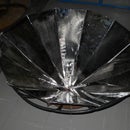Introduction: Add Functionality for More Fun: Backpack Hip & Chest Straps As Well As Laptop Protector Pouch.
To all my fellow backpackers
Many backpacks would benefit from having hip straps. Some hiking bags do come out with decent ones, but I found that the basic hip straps are very uncomfortable when you need them most.
Another aspect where a backpack upgrade would be very beneficial would be to have a decent laptop pouch. Again the decent backpacks that have these are typically sold at high markup rates at electronics stores with little thought paid to the serious backpacker.
Step 1: What You Will Need
- A backpack that requires some modifications
- Chest strap and hip strap from another old bag, or the parts and machines required to fabricate these
- Very tough thread, such as serafil (see picture attached) or even dental floss or fishing line could do the job.
- a lighter if you want to melt the edges of the straps to prevent them from pulling apart.
Disclaimer: I am a total beginner when it comes to sewing, and I had an old hiking bag from which I salvaged the hip and chest straps. Making these up yourself is not impossible, but requires some machine sewing or some very dedicated hand stitching, I recommend considering repurposing that old sports bag stored away somewhere. There is quite a bit of salvageable material on those bags.
For the laptop bag
- A section of a hikers foam mattress
- Some thread, yarn, rope or fishing line that can be threaded
- A sail needle, or a carpet/canvas needle.
Step 2: Connect Up the Chest Straps
The chest straps I fastened by stitching a loop around the shoulder straps, the chest straps assist to keep the shoulder straps from moving around too much and improves the fit so that the backpack doesn't ever lean back too heavily.
The chest straps can be made up of any spare straps/straps from an old bag. I find them to be extremely tough and durable, but I prefer a more padded option for the hip strap.
Tip: To prevent the straps themselves from ever pulling apart I first melted the edges together with the flame of a lighter, then I doubled up the edges and sewed them together.
Step 3: Sew on the Hip Straps
If you have never hiked 20km or 12 miles in a day before, then you would probably think to add hip straps is not that important, but if you have ever tried to carry more than just a rain jacket the whole day in a backpack, then I am sure you will also appreciate the reduced back strain which hip straps have on your overall backpack-experience. After packing my backpack optimally (keeping the heavy things close to my back) I am usually able to reduce the tension in my shoulder straps such that all the weight is transferred through my hips.
I used the serafil thread (listed in the previous step) to stitch the hip straps to the shoulder straps, it is much easier than trying to thread through the thick backpack and you should end up with a very durable connection that will serve you very well.
I start by threading the needle, and I take an arm's length of thread, pull the thread exactly half way through and tie a knot with the ends. Now I know that my needle won't pull loose, and I stitch with a double thread and therefore require half the stitches to get the same strength.
I use my first stitch and loop into it, so it is not possible to pull out and I can tighten the stitches to a taught tension at each stitch.
Step 4: Add the Impact Protected Laptop Pouch.
For added protection of the laptop, I beefed up a basic laptop pouch by sewing together a foam cover made out of an old hiker's sleeping mattress.
This is to better protect it from impact, for example, when you come home tired and just want to drop the bag in the corner. This cheap addition may end up extending the life of my laptop and even reduce possible damage to it in the event of an accident. Cut the foam to a size that will cover the laptop snugly, don’t skimp on the corners, that is the most critical part where it needs to be protected the most.
- Cut some slots as indicated so that the overlap can be stitched in the closed up shape.
- Use the laptop as a constant guide of the eventual size you would like to achieve, taking care not to prod the needle into your electronic device.
- Stitches may be quite far apart, but take care not to pull the stitches tight, this will rip the foam and damage the connection. The idea is only to keep the foam in position with the thread.
Having a material pouch like the one I have at hand is quite handy to keep the laptop in until you want to use it, thereby keeping it protected from dust and a potential drop to the floor when not in use.
Step 5: Go on a Trip With Your Backpack
Having a trusted backpack is non-negotiable on a traveling trip.
If that backpack you really like doesn't have all the functionality you need,
then consider a DIY upgrade.
You will be glad you did it,
Wherever you find yourself thinking about
The good road you are upon,
and not the uncomfortable bag you are dragging along.

Participated in the
Backpack Challenge












